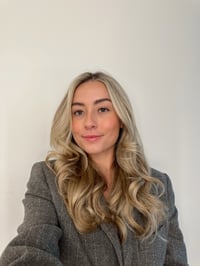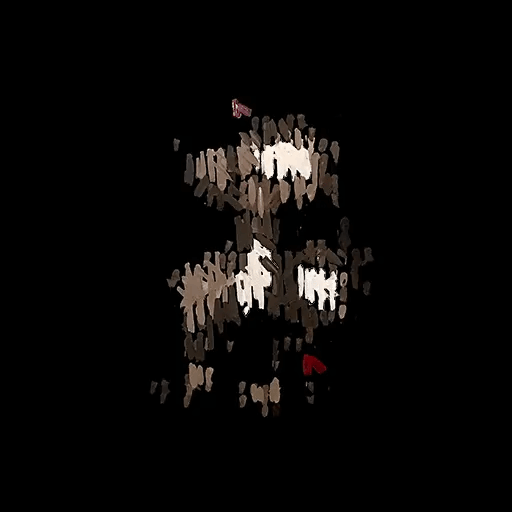About the artist:
Scerbo is an Italian contemporary artist currently living and working in Biella, Italy. His practice explores the complexities and contradictions within human history and nature. Having a formal education in computer programming as well as philosophical studies, it was the combination of these two areas of study that ultimately led the artist in search for innovative and accurate ways to express his internal dialogue around human existence.
A series of experiments with drawing, painting, abstract sculptures, and videos followed, culminating in 2019 with the discovery of photography and digital painting as the most poetic and intimate means of exploring the relationship between the body and the new.
Scerbo, in fact, views photography as the means to absorb and impart tangible meaning to abstract, indeterminate and existential conditions stored within light — The basis of his research, leading to his first minted work on SuperRare, “Photogravity” (March 2022).
An intuitive approach to the image that strives for a perceptive dissociation that separates seeing from hearing, transcending photography into the realm of abstract painting, which embodies a rhythmic vibration on a more subtle, essential level.
"Participating digitally in the body is almost an oxymoron, yet it seems that the digital experience can somehow be lived with the same degree of intensity as the physical one, or perhaps to an even greater degree. Harder." - Scerbo
The Interview:
1. Paloma: Can you pinpoint a moment when you knew you wanted to be an artist? Was anyone in your family an artist prior to you?
Scerbo:
In contemplating my journey towards becoming or identifying as an artist, I find it inadequate to frame it as a deliberate choice, subject to the conscious act or to a specific moment in my childhood. But rather, I see and understand the essence of my artistic experience as it emerged from the seamless integration of creativity into the fabric of my existence, a revelation that unveiled itself between the lines of my life's narrative.
“I don't think you can decide to become an artist. Or rather, I can do it in the same way that I am choosing to write this response as a work of art that reveals my being between these lines. So the only choice I made was to transform the obviousness of my action into something that isn't.”
- Scerbo
My maternal grandmother's brothers were watercolorists, my mother wrote poetry, my sister illustrated narratives through comics, and our house was filled daily with the sound of jazz music. I lived in a home that was engulfed in all forms of the arts. All of my family members expressed themselves artistically and it was through my keen observation and in absorbing their collective creative energies, that I acquired my "artistic destiny" without outwardly externalizing it. This form of "non-action" enabled my unconscious mind to undergo a transformative process in creatively reinterpreting stimuli. This unconscious quality proved essential in teaching me not to deliberately interfere with the organic workings of my unconscious mind, allowing it to operate autonomously. In reflecting on this, I believe a crucial aspect was realizing what my brain/spirit was doing without my direct intervention of my conscious self.
As a child I experienced observation as a form of creative privilege, no one really knew what I was inventing in my mind and this offered me a profound sense of strength and autonomy from a young age. When reflecting on this crucial moment when I embraced the role of an artist I am inclined to believe that this decision, if it can be labeled as such, arose in my early years. It was not a conscious choice but a subtle realization that, in imagining myself as an artist, I was authentically sculpting the contours of my future.
Thus, this “non-action” proved to be a powerful tool for me in my understanding of the strength behind internal or imaginary visualization. It provided a profound awareness of the notion that imagination, when pushed to extreme levels of intensity, transcends mere abstraction and can materialize into genuine creation. So, as a child, I believe, this concept of “non- action” was fundamental in ultimately writing my story as the artist I am today, because no external factor could destroy this vision.
2. P: Can you tell me about your affinity for artists such as such as Vito Acconci, Chris Burden, Gina Pane, Charles Ray, and Francis Alys? What is it that inspires you or connects you with them as people or in their philosophies?
S: The connection I feel today with the work of these artists is different from the one I felt in the years between 2016-2018. The "performative" aspect that I admired so much a few years ago was fueled in this desire to push the physical body to its highest point of expressive autonomy, freeing it from the "didactic" support of conceptual language. Their gestures artfully unveil the profound significance of body language in human communication, challenging the prevailing cultural trend that prioritizes scientific reasoning and consequently, rational and logical verbal language as the sole credible means of self-affirmation.
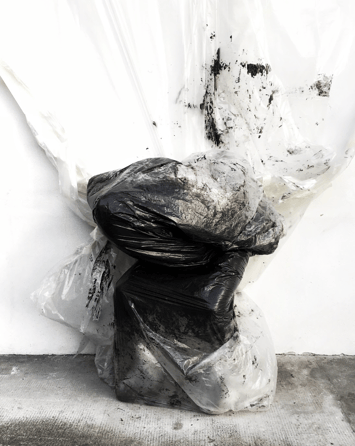 Blow, 2017
Blow, 2017
The affinity I feel is instinctual, animal and ancestral. I have always felt disarmed in front of their pieces, especially when looking at them on a digital screen. And this is precisely the point that fascinates me most today: participating digitally in the body is almost an oxymoron, yet it seems that the digital experience can somehow be lived with the same degree of intensity as the physical one, or perhaps to an even more profound degree.
“ If just 5 years ago I was connected to this work from a purely "existential" point of view, today I feel decidedly more attracted to the technological tool that allows my senses to participate in such powerful artistic contents without altering their existential significance.” - Scerbo
3. P: You show this strong interest for the abstract, specifically in installation work, can you tell me a bit more about this and how you see your work in dialogue with the medium?
S: To me, abstraction encompasses everything left unsaid, unexplored in thought, unnamed, and undetermined—a realm that evades and yet challenges our preconceived notions of explicit definitions, remaining in some ways elusive. Abstraction is a pure creative fact. When I was a child, I watched my grandfather from the balcony while he chopped wood with an axe. Hours and hours spent doing the same gesture: take the log, place it on another larger log, bring the axe up, exploit the force of gravity and hit the log. The only gesture that broke the process was when he took the linen handkerchief from his shirt pocket to wipe the sweat from his eyes.
This is what I love about abstract installations: the artist completely distances themselves from what they are doing, exploiting the transcendent power of the gesture they make, leaving a trace of their work in the space. No theme, no ideal reference, no intellectual position. Only the emanation of a state of shaped creative energy. For years I have used large wooden logs in my installation work. I did what my grandfather did: I positioned the log, found a natural crack, inserted a 5/6 mm glass sheet into the crack, took another log and placed it on the glass sheet stuck in the first log using the crack in the second log.
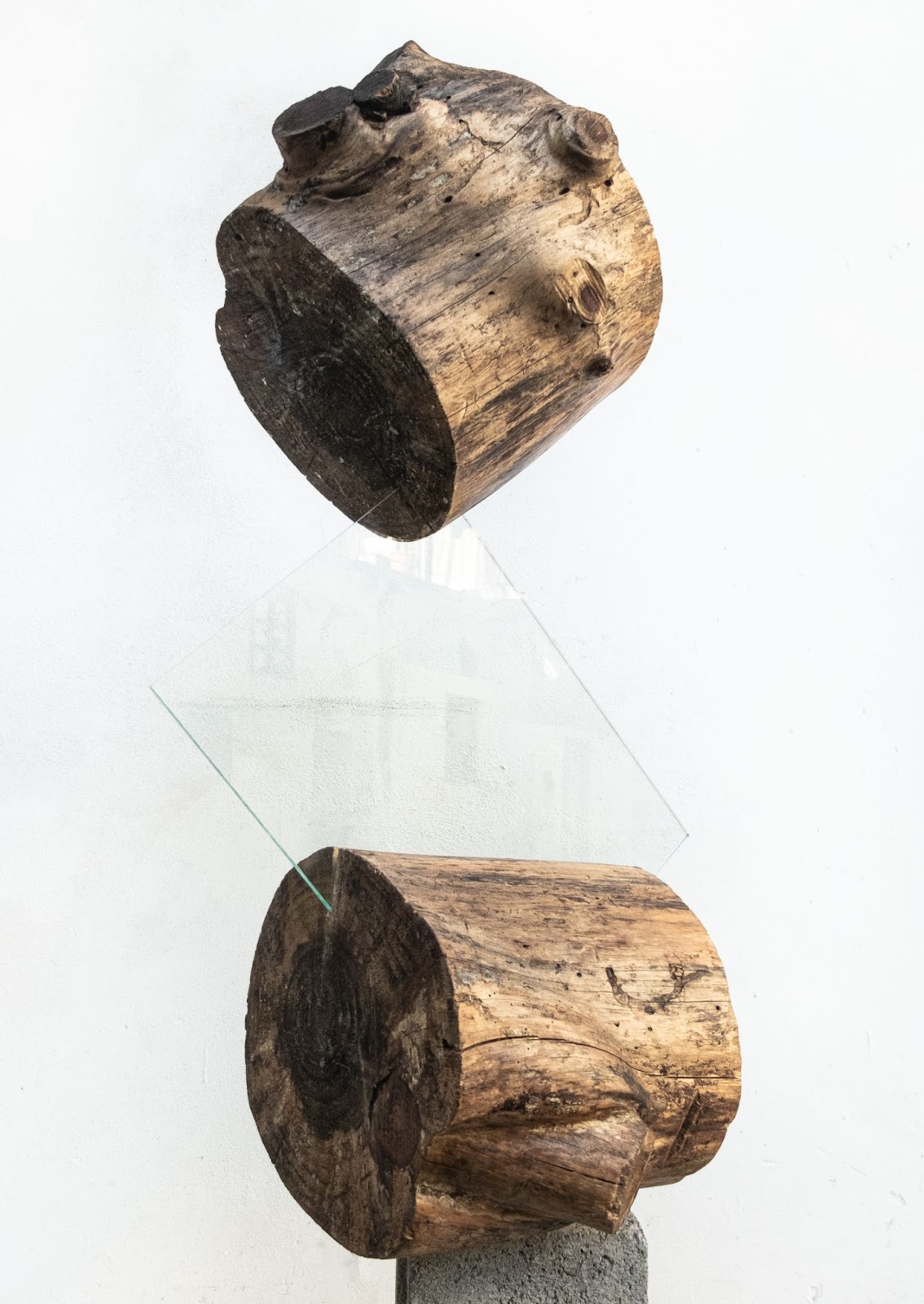 Relazione precaria, 2018, 18 kg wood and glass
Relazione precaria, 2018, 18 kg wood and glass
4. P: Capturing the fleeting and transient moment in life through photography is something you look to explore within your work. Most recently you created a body of work titled “Anti Crash Series” can you tell me a bit more about this series of work and how you aimed to capture the fleeting through your work?
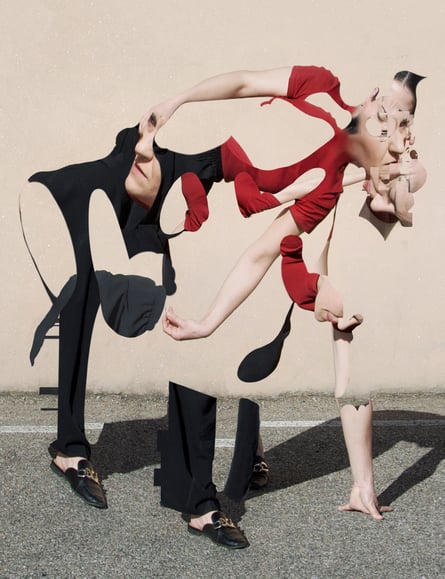
Elendorphyna, 2023
S: Anti-crash_jpg is inspired by itself. The collection was born out of the illusion of having made a mistake during its conceptional period. I have always worked using photography as a means of expanding the energies that inhabit me. In my first collection titled "Voce del verbo," I created a body of work by fusing photography with AI jpg outputs, which culminated into an explicit and concrete dialogue between the two dimensions.
In anti-crash_jpg, I worked in the same way from a process level, with the exception of the literal integration of AI visual data. This was the first time that I was no longer using or creating with the integration of AI as a tool throughout the process of the work itself, but rather looking to study the embodiment of artificial intelligence and how I could create work from a human perspective that mirrored that of the machine. This was the first time that I, as the artist, was acting in a sense as “the AI” myself.
I have voluntarily maintained a technical/practical detachment with AI to leave my photographic work intact in its intimate origins to leave it extremely vulnerable to new trends, exposing it to the impossibility of not risking its crash. I work with digital brushes that I have glitched into the tip software settings source code, creating brush shapes that approximate basic geometric barcodes or digital stamps. These glitches are used to "pierce" my overlayed shots on different levels of depth in the alpha channel. They are almost always from 3/11 shots that I take of my subject assuming different postures in the same setting. After making my transparency hole codes, I fuse the photographs down to the image that satisfies me. In a way I emulate what an AI does when it creates versions of the same image. It approaches a "human-software" performance if we want to see it that way.
The shots used for the creation of Anti-crash_jpg all come from situations of daily life experienced mainly in the interpersonal and sentimental relationship with my partner, my mother and my closest friends. It is precisely this provenance that is subjected to the risk of losing its visual memory, to being subjected to the disturbance that is penetrating into it. In Anti-crash, the fleeting nature of the photographic moment emerges with the transience and intersection of the digital internet.
.jpg?width=331&height=419&name=Grandmother%20Staircase%20Selfie%20(1).jpg) Grandmother Staircase Selfie, 2020/2023
Grandmother Staircase Selfie, 2020/2023
The visual encountered while navigating our online streams is fleeting, allowing little before another swiftly takes its place. This experience or phenomenon generates an involuntary glitch in human perception, which alters visual participation in any content, thereby transforming the nature of visual engagement with any given content creating images contaminated and corrupted by our online habits. The pieces in this collection capture a confusing and misunderstood testimony to the digital perception that is created in a nanosecond in the eyes of users. A demonstration of the digital visual perceptual that materializes in the blink of an eye within the gaze of users.
5. P: How do you see photography and blockchain technology as an example of ways in which technological evolution and artistry has challenged or redefined the ways in which we can understand what it means to be human? What it means to be an artist?
S: It's hard to "understand" what it means to be human. The scope of meaning to be attributed to such a response is comparable to a dam built on the magma river of an erupting volcano. And the dam would be dissolved before the power of nature could be stemmed. Having said this, one can always think of being as a form of fluctuating energy that propagates, emanating its own existential history: the trace left by its passage is what makes it worth creating art for today, and blockchain technology is certainly one of the most advanced tools to guarantee the indelible memory of the artistic passage of our century.
Although the nativity of digital purity is a preferable requirement for many users of the web3 space, I believe that the photographic tool enjoys a particularly poignant feature here: the click captures light propagated in biophysical space-time, and acts as one's data memory transfer. state of being and digitally returns a vibrational frequency of this "physical" condition. The boundary that separates the reality of body/telematic data is completely dissolved and freed from the idea that "being human" means being something deterministic at the level of real experience. Here, photography merged with blockchain technology seems to me to be exactly a form of liberation that the artist models so as not to define their trace in any way and consequently their definability.
6. P: You mention a profound shift within your career that inspired a cursory and affinity for photography as a medium of expression. Can you tell me about this period in time and how you came to explore photography as a result of the pandemic?
S: I was experimenting in the field of sculpture and installations. Between 2014 and 2018, my artistic endeavors were grounded in my philosophical foundation, primarily exploring the interplay between thought and matter. During this period, I concentrated on creating site-specific installations that delved into the examination of visual art's equilibrium. This exploration involved contrasting robust materials like concrete, stone, and wood with more delicate and transient elements such as glass or light—both natural and artificial. I worked diligently every day in my backyard, generating temporary visual scenarios that often eroded in less than 24 hours.
One cycle: creation-photo-destruction, creation- photo-destruction, creation-photo-destruction.
I was driven by a ravished intuition, fueled by an unquenchable thought process that needed to find a partial and temporary completeness, that paralleled experience as a state of change and existential transience. However, this dynamic, made up of ideal coherence, brought about a profound sense of emptiness which slowly turned into anguish over loss. The only trace of experience were the shots I had taken to document the installations. At that moment I realized that photography was the only tool capable of capturing what neither my mind nor my sensitivity could focus on. It was a way to physically absorb an abstract and indeterminate existential condition that went beyond thought, capable of tangibly illustrating perception through the memory contained in light- it was the meat and bones of my work, the foundation of my research.
The pandemic, inside me, has exasperated the desire for comparison with the body, it has hatched all the most basic instinctual larvae of my animal dimension. The lockdown had made the mental imagination more concrete and palpable than the bones that support us, limiting carnal experience within the confines of the dream. Everything that allowed me to have a shred of biological relationship automatically became the object of artistic celebration: the shot was an almost ritual moment to archive data of an uncertain human condition which until a few weeks earlier seemed to be the driving force of life.
7. P: How do you see photography as an escape from a medium such as painting? How do you hope to explore the possibilities embraced through this medium in search of a more poetic understanding of the human body and its interaction with the digital age and sound?
Girosutemicaldi, 2021
S: Well, this question is a theft from the poetry of my fingers that are pressing these keys in search of a rhythmic movement on the keyboard that can transfer directly into this answer. Here you see, painting on the keyboard would be the result of my dancing fingers, it would be a deductive output of my noble gesture, while a series of shots of my hands in this moment would be an input to the imagination of whoever is reading this text. Nothing would be taken for granted given that there would be nothing to read other than my hands on the keyboard and the cold light of the screen would be the key to the relationship between photography and digital because it would not reveal anything about the work but would be its light, and not It seems little to me.
While the sound I have written about so far is clearly visible in the pauses between these words, in the uncertainties about the appropriate or inappropriate meaning of my response. The noise generated by visual art has always been chatter with too much resonance, while the idea of photographing it remains digitally silent but has a deep echo that vibrates in the eyes of those who are sensing it.
8. P: Sound is a crucial element within your work. Can you tell me more about your background in music and how you explore the use of sound through your work?
S: When I was just two years old, my first encounters with the terror of loud sounds began. Any life situation in which my hearing had to deal with loud sounds was an inconvenience for me and my family. The train, the ambulance, the vacuum cleaner, the firecrackers, the vehicle horns, the washing machine, the megaphones and much more. Each time, my mother would intervene by placing headphones on me, filling my ears with the soothing melodies of musicians like Bill Evans, Miles Davis, Charlie Parker, Brian Eno, Bryan Ferry, Kate Bush, and others she adored. These musical interventions became my antidote to trauma throughout my pre-teen years. Paradoxically, music was the acoustic insulation between me and the sound of the outside world.
Later, after a few years, it was understood that I was born with an auditory hypersensitivity and this made me hear sounds enormously amplified compared to normal perception. My relationship with music was constant throughout my early childhood development and gave me refuge for many years. After my first experiments with the guitar, the desire was born in me to "break" that placenta with music as a protection to face the rawness of the sound space understood as a purely acoustic vibratory frequency.
My first experiments with sound art date back to the year 2015. It was in this period, I started recording sounds of all kinds and assembled them digitally in a purely experimental way. I obtained audio tracks completley devoid of harmonic or melodic metrics, stripped of any syntax. They were just sounds to vibrate "under" my video art pieces that I made in those years. Subsequently, I began to delve deeper into the idea of sound frequency as a visual possibility and I approached the interest of the rhythmic aspect: the rhythm frees the sound from the emotional reference and pushes the perception towards a more universal experience of matter, that is, pulsation. Electricity is vital energy. I began to exploit the rhythm of my tracks, transforming the oscillation sequences of the sound wave as metric patterns for the construction of my videos and I have arrived today with this idea which led me to the creation of my latest digital collection "jpg pulsar mode".
In this specific series I created animated loops of my glitched shots overlaid on multiple alpha layers that follow a sonic rhythm line without emitting sound. The work visually swirls you into the visual pulsar, revealing its sonority only in the silence of the moving image.
9. P: With this in mind, you mention this interest in the creating work that transcends photography into the realm of abstract painting? Can you tell me a bit more about what you mean by this?
S: I would like to photograph the frequency waves emanating from my shots and use the jpg patterns created as wallpaper to be used in turn as a background to photograph the same subject as the shot I started from, and then repeat the same action starting from the photograph obtained with this process, until the photographed subject is no longer distinguishable from the background of the room that hosted it. So, I would like to act like an abstract painter. Excluding the representation from the horizon and concentrating on the rays emanating from the subject I am photographing, using the sound of the click of my camera as a mantra to encourage real enlightenment during the repetition of my photographic gesture until the moment in which I can finally forget about being a I photograph and I can start using the light absorbed by the lens as a private tool to forget the walls around me, giving my thoughts to the eyes of those who were observing me.
“ I mean, abstract painting pulsates but hardly tells; a photograph tells but can hardly pulsate.” - Scerbo
10. P: Can you tell me a bit more about your work on SuperRare titled Photogravity, 2022?
 Photogravity, 2022
Photogravity, 2022
S: Photogravity was my first piece listed on the blockchain. My whole "web3" story begins here. I created this work thanks to meeting important new friends in my life in 2020. I was going through a dark period, I felt the weight of existence on my shoulders. The force of gravity was too intrusive, it seemed as if the earth was trying in every way not to make me soar towards my desires. But, this newfound friendship was an irreplaceable reinforcement, the support of an authentic person is a value that should never be underestimated because it can change your life. The strong arms, their warmth in dark moments, it is as if they had participated in my gravity by taking on my existential experience. This is called empathy, and it is priceless.
11. P: Can you tell me about your digital glitch- infused paint brush and how you integrate AI within your artistic process?
S: When I started to develop my more concrete digital way, I had a strong inspiration from everything related to glitch art and generative art. But I absolutely didn't want to do generative photography or work on my jpgs from a code-only source. So I started to "bug" the source code of the brush settings of the software I used to paint on my tablet. I managed to get some digital brush tip shapes very similar to a barcode and started using that shape to punch holes in my overlapping jpgs between alpha channel layers.
Voce del verbo Fotoscannare, 2022
In looking at this work above we can see an example of this use of the digital brush which I have created come through in the work. The composition encompasses all of the interests in overlap from the evolution of my digital brush, exploration of AI and photography in the abstract to create this new work, which speaks in dialogue to all of these interests I have been exploring over the course of the years in my work.
The transparency holes that I create between my jpgs are perfect for allowing fragments of other jpgs to emerge which combine with each other, generating visual chaos which automatically becomes a stimulus for my digital painting intervention which I experience as a sort of " digital surgery" or "suture" where I manually visually unify my entire composition by exploiting the wounds of the alpha holes. In my first collection "Voce del Verbo" I integrated into this process some experimental results that I obtained from my AI work generated with Dalle. I didn't worry so much about what I generated with the AI, as what interested me was the possibility of merging my photography with the AI's digital data. I wanted the light of my shots to be exposed to the ghostly presence of an instrument from my historical period. The best way to do this was to treat the AI jpgs the same way as my camera jpgs, so I fed the AI outputs into the alpha layers of my software and started poking holes in them too with my corrupted brush.

